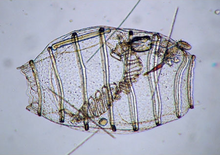Doliolida
| Doliolida | |
|---|---|
 |
|
| Unidentified species of Doliolum about 1.4 mm long | |
| Scientific classification | |
| Kingdom: | Animalia |
| Phylum: | Chordata |
| Subphylum: | Tunicata |
| Class: | Thaliacea |
| Order: | Doliolida |
The Doliolida are an order of small marine animals of the subphylum Tunicata. They are in the class Thaliacea, which also includes the salps and pyrosomes. The doliolid body is small, typically 1–2 mm long, and barrel-shaped; it features two wide siphons, one at the front and the other at the back end, and eight or nine circular muscle strands reminiscent of barrel bands.
Like all tunicates, they are filter feeders. Unlike the related order Ascidiacea, which are sessile, but like the order Larvacea, they are free-floating; they take in a flow of water, from which they gather the plankton on which they feed. They then force the water through their bodies and eject it out through the rear siphon in a jet that propels in a way that suggests a tiny ramjet. This is an effective means of propulsion, by which Doliolida can move quite quickly.
The Doliolida have a complicated life cycle that includes sexual and asexual generations. They are nearly exclusively tropical animals, although a few species do occur as far to the north as northern California.
Doliolids alternate through sexual and asexual generations. The sexual generation consists of individuals featuring eight muscle bands, each having male or female gonads. These individuals are called gonozooids. Fertilized eggs produce slightly different individuals, featuring nine muscle bands, no gonads, and two stalks growing from each individual's body: the shorter one at the ventral side, and the longer one growing from the dorsal edge of the posterior siphon. These asexual individuals are informally called "nurses", and each one produces an astonishing number of mature progeny asexually; such progeny include both sexual and asexual zooids in three sequential "generations".
...
Wikipedia
